Stuffed cabbage rolls (Gołąbki/Golabki) is a classic Polish dish made with ground meat stuffed in cabbage leaves then served with flavorful tomato sauce. You will get lots of tomato sauce with this recipe! This is an authentic recipe for Polish cabbage rolls.
If you want all the flavors of stuffed cabbage rolls but without all the work, check out this recipe for stuffed cabbage soup!
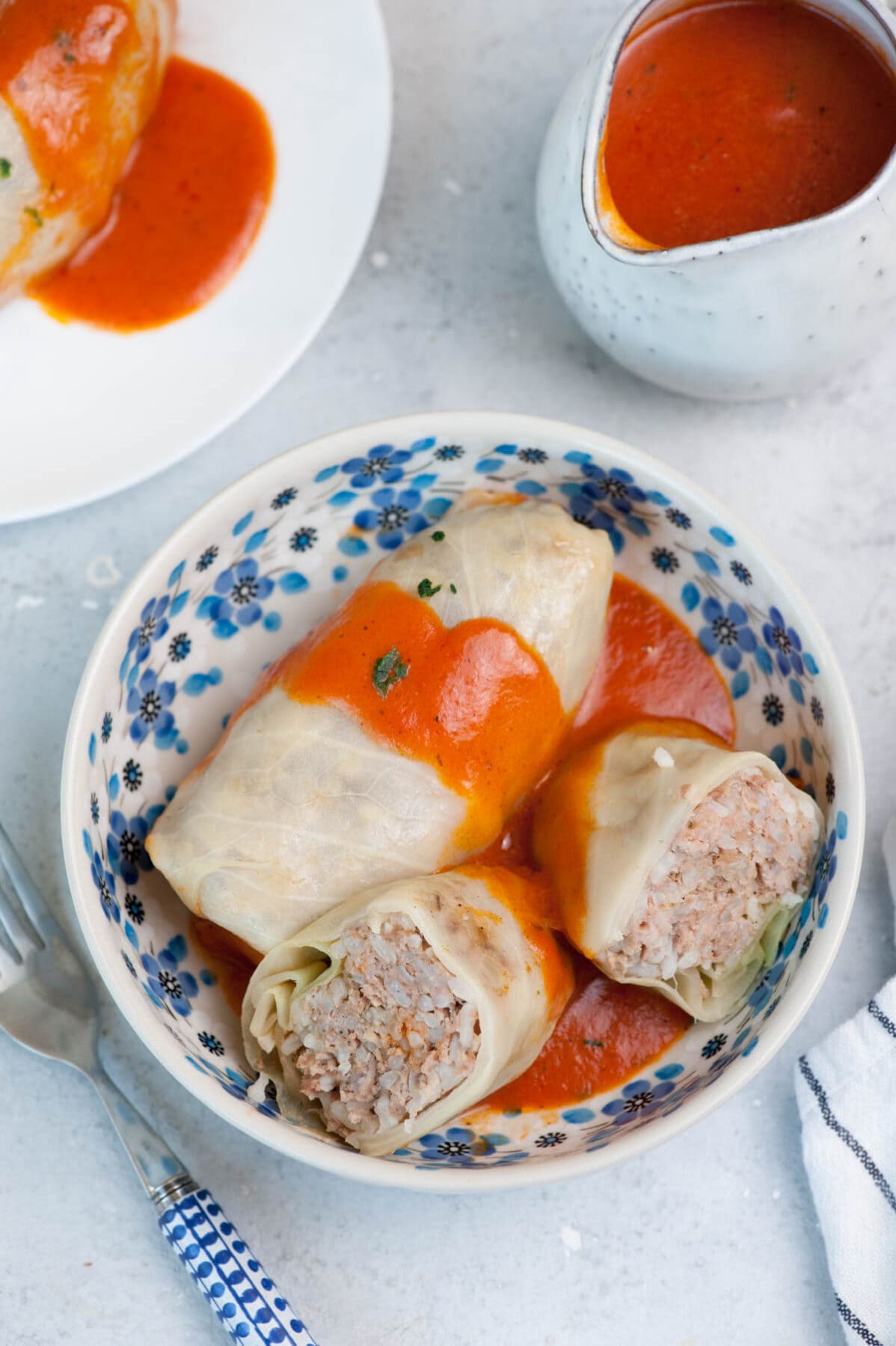
What are cabbage rolls?
Stuffed cabbage rolls are a popular Polish dish (called gołąbki, already plural) consisting of cooked cabbage leaves wrapped around ground meat and rice filling. Gołąbki means „little pigeons” in Polish.
Why is it called golabki? Polish etymologists are not sure!
There are two theories:
- The first one says that this word was borrowed from the Ukrainian or Russian language where this dish is also very popular. It was a symbolic name, the pigeons were considered pure and strong, so this dish would give the person eating it these features.
- The second theory suggests that this dish could be inspired by a fancy French dish – stuffed pigeons baked on top of cabbage leaves. French cuisine was very popular in Poland XVIII-XIX century so this dish gained popularity among the Polish aristocracy. It was quickly adapted as stuffed cabbage by lower classes.
Gołąbki are also called golombki, golumpki, golumpkies, golumpkis, or gwumpki. Only the word „Gołąbki” is correct and used by the Polish people.
How do you pronounce gołąbki in Polish? It’s pronounced “gaw-woamb-kee.” You can hear it here.
This dish is also popular in Russia (golubtsy), Ukraine (holubtsi), German-speaking countries (Kohlrouladen), Scandinavia, Czech Republik/Slovakia (holubky or halupki), Hungary (töltött káposzta), and Balkan countries (sarma – they are made with fermented cabbage!).
Ingredients
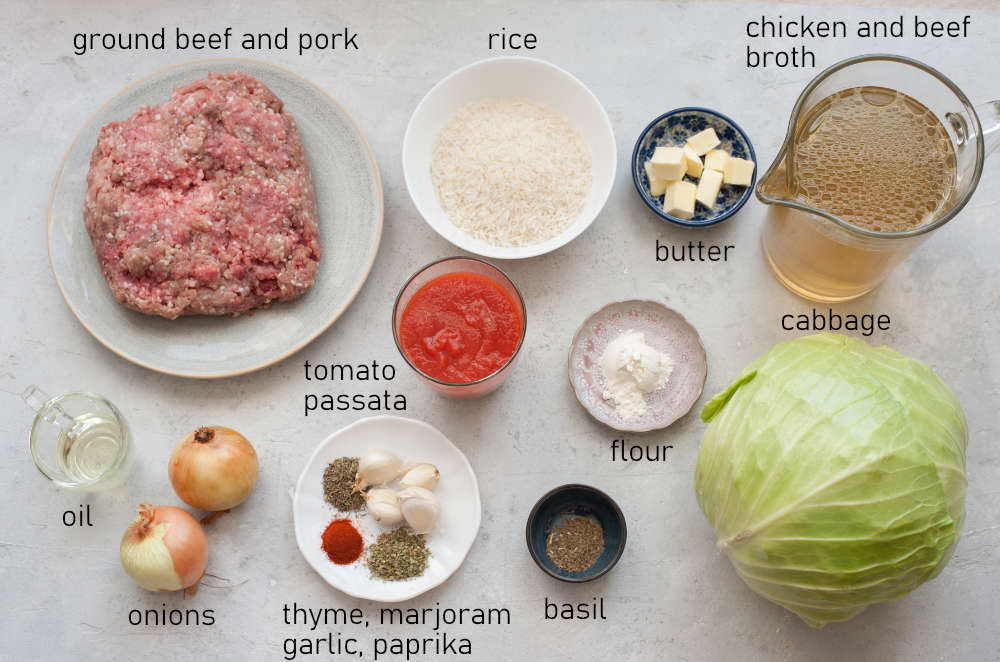
- Cabbage – You can use white cabbage (this is what I prefer) or savoy cabbage, many Polish people prefer savory cabbage but we like white cabbage more. Savoy cabbage is easier and quicker to use. You can also use young cabbage, it just needs to be cook for a shorter period of time. You will need a medium or large cabbage. Don’t buy small cabbage head – the leaves will be to small to stuff them.
- Meat – most Polish people use ground pork (eg pork shoulder), but a mixture of ground pork and beef is also commonly used. Some use a mix of pork, beef, and veal. For us, the golabki with ground pork and beef are most flavorful. To reduce the calories you can also use ground turkey – I prefer the dark meat (ground turkey leg).
- Rice – it’s the most common filler for golabki. In the old times it was used to reduce the amount of meat which was very expensive. Golabki with just meat were a sign of prosperity. I like my golabki with rice, it makes it a whole meal so I don’t need to make any side dishes to serve the golabki with. Instead of rice, buckwheat groats or barley are being used. You could also use quinoa or cauliflower rice.
- Spices – golabki are traditionally very mildly spiced, usually just onion, garlic, salt and pepper are being used. I like to add marjoram, thyme and a little bit of paprika to mine.
- Broth – I’m using chicken broth and beef broth to cook the golabki. The broth is used to cook golabki and it makes the base of the tomato sauce.
- Tomato passata – also called tomato puree. It’s a thick sauce of pureed, briefly cooked tomatoes that have been strained of seeds and skins. It makes an excellent base for the tomato sauce. In Poland, tomato passata or tomato paste are used as a base of the sauce.
- Cream and basil – these are unusual ingredients for tomato sauce but I promise you, the sauce tastes so much better with them. You only need a small amount of cream so the sauce taste mostly like tomato sauce with just a hint of creaminess.
What could you also add?
I tried to make my recipe as traditional and basic as possible but there are many ingredients you could add to make this dish even more delicious:
- add roughly chopped sauteed mushrooms to the filling – it’s super delicious
- you could add crumbled bacon pieces to the filling or wrap each cabbage roll in bacon slices
- I’ve heard some people add a couple of slices smoked bacon to the pot with golabki
Recipe variations
Vegetarian stuffed cabbage rolls are very popular in Poland. The most popular recipe uses buckwheat groats and mushrooms.
Not a fan of tomato sauce? You can make cabbage rolls with mushroom sauce (chanterelle sauce is often used)!
Preparation methods
The most popular preparation method of golabki in Poland is the stovetop method. Baking cabbage rolls is also known, but less popular.
Golabki are usually cooked or baked in broth and not in tomato sauce. The tomato sauce is based on leftover golabki cooking liquid. I prefer this method to cooking/baking golabki in tomato sauce. This produces a better tasting tomato sauce and you can make it as much as you like.
Stove-top vs oven: for me, there is no big difference in flavor when using both methods. Maybe baked golabki are a little bit tastier because the cabbage browns while baking but other than that they taste pretty similar.
Some people brown the golabki after rolling them up – just pan-frying them on both sides in a pan until browned then simmer on the stovetop. I haven’t tried that yet. I think it would add more flavor but this is an additional step of preparation of a dish that is already time-consuming.
How to soften cabbage for cabbage rolls
- Cook the cabbage in a pot (described below)
- You can freeze the cabbage: core it and wrap in plastic foil, freeze (at least overnight), then thaw (at least overnight + a couple of hours on the counter). Freezing changes the texture of the cabbage, it’s more soft, but I must admit, this is a huge time saver so if I manage to plan ahead I freeze my cabbage. When defrosted the leaves peel off very easily.
- In an Instant Pot (I haven’t tried that method yet, just read about it): put it on a trivet and steam it: place core side down, add 1 1/2 cups of water, press steam button or high pressure button (manual) for 5 minutes, then do quick release & transfer to a bowl when done.
- In a microwave (I have also not tried this method myself): core the cabbage, wrap in a damp paper towel, place in a microwave for at least 5 minutes, peel off your leaves, and stuff. If it’s get difficut to peel off the leaves, put it back into the microwave then peel off the leaves.
How to make golabki step by step
Prepare the cabbage
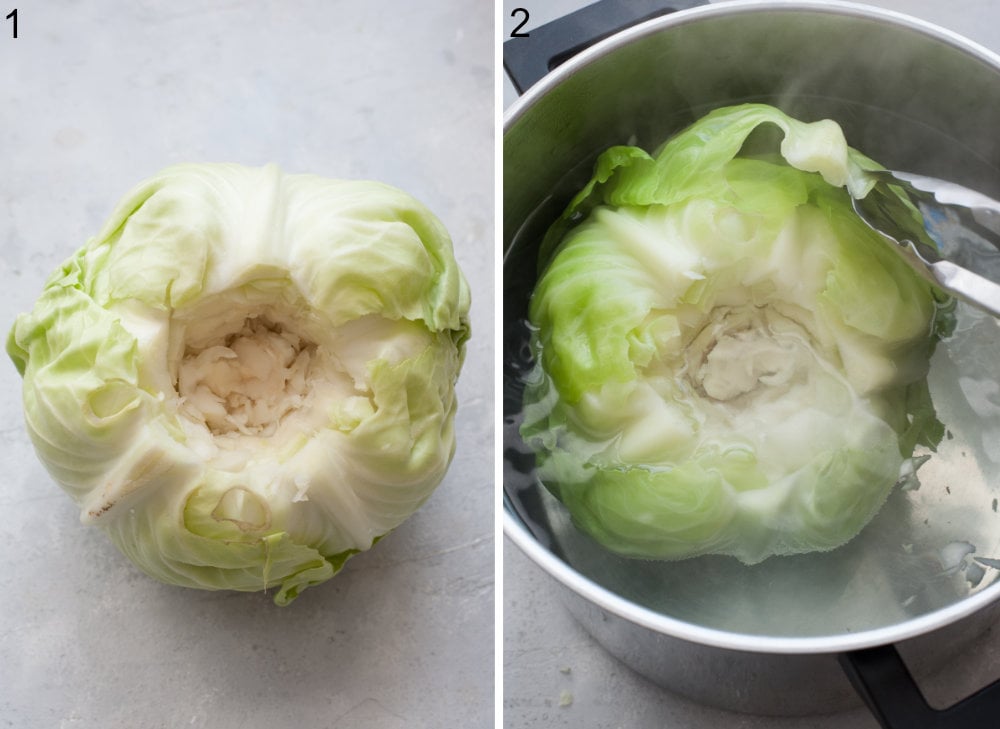
STEP 1: Core the cabbage: using a pairing knife, cut out the core of the cabbage, about 1 1/2-2 inches (4-5cm) deep. Make sure to cut it out wide enough so that the leaves are not attached to the core.
STEP 2: Cook the cabbage: In a large pot, bring a large amount of water to a boil (enough to cover the cabbage). Add the cabbage, core-side down, cook for 10 minutes, then turn it over (it should be core-side up now) and cook for a further 5 minutes.
Peel the leaves off one by one using tongs while the cabbage is still in water, stack the leaves on a plate. Grab the cabbage with tongs by the stem, trying to not damage the leaves. The point here is not to cook the cabbage but to separate the leaves and soften them. They should not be completely soft (fully cooked) but only pliable. If the leaves are not separating try to separate them from the core with a knife (if you’ve cut out too little). If your cabbage leaves are still not soft enough to be easily pliable you can add them to the pot and cook them a little bit longer. Don’t overcook the cabbage or the leaves will tear.
You will need about 16 leaves.
Prepare the meat-rice filling
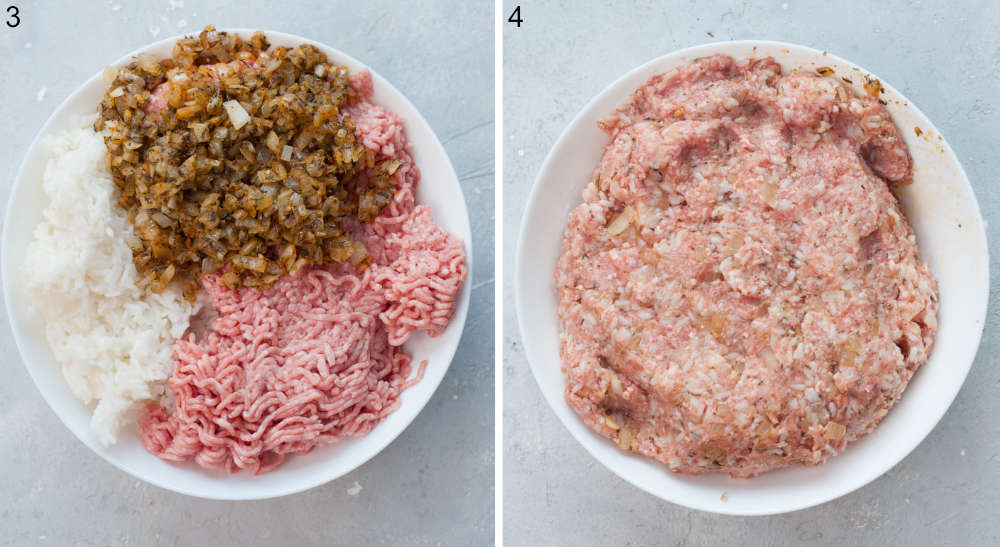
STEP 3: Cook the rice until almost cooked – about 1-2 minutes shorter than the usual cooking time. Drain.
Cut the onions into cubes, press the garlic through a garlic press. Heat the oil in a frying pan, add the onions, cook for 5-7 minutes until soft. Add the garlic and spices, cook, stirring, for 20-30 seconds. Add into a large bowl.
STEP 4: Add the meat and cooked rice, season with salt and pepper (I added about 1 1/3 Tbsp of fine sea salt and 1 ts of ground black pepper but I prefer that you add them to your taste).
Stir until the mixture is combined.
Stuff cabbage leaves
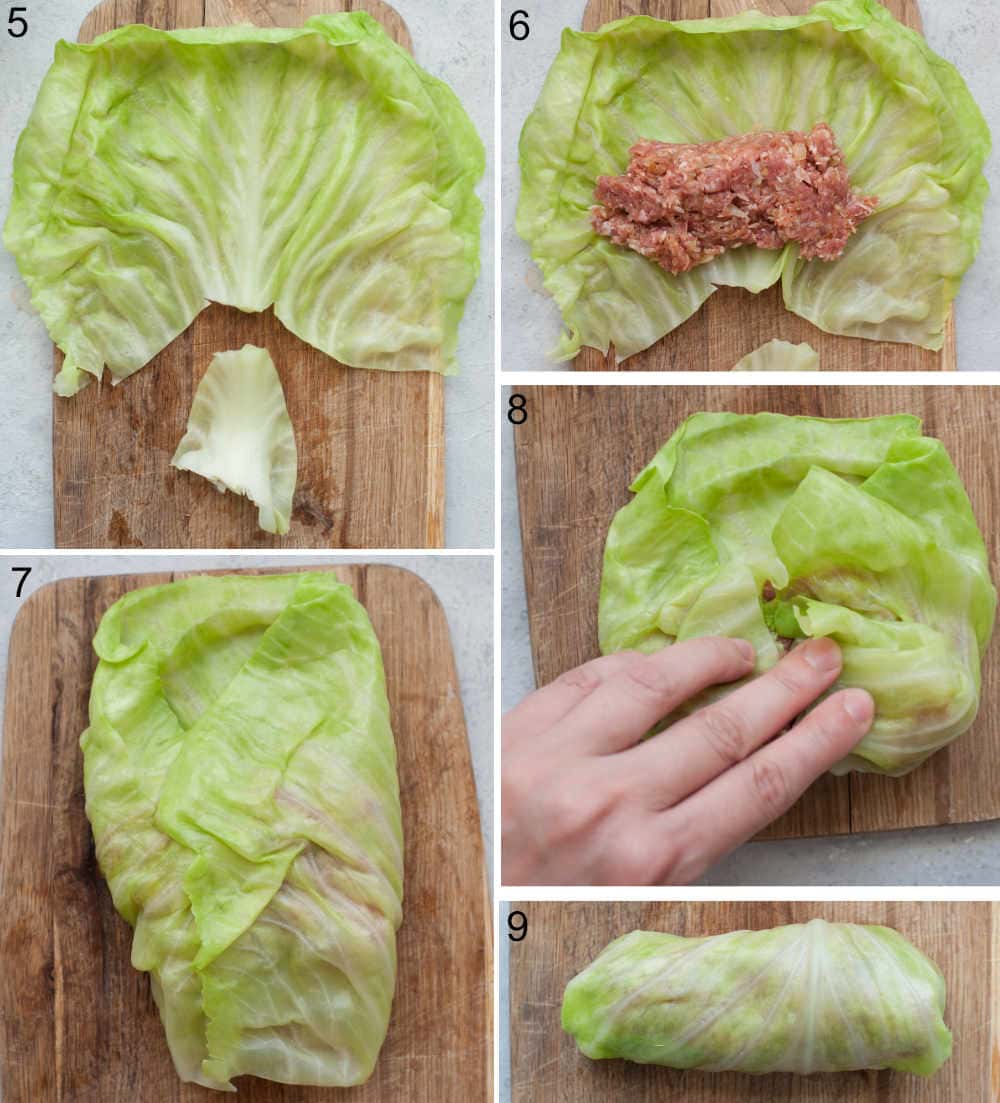
STEP 5: Cut out the thick part of the core.
STEP 6: Place some of the filling in the middle of each leaf.
STEP 7: Fold the right and left part of the leaf to the center.
STEP 8+9: Roll up starting from the end facing towards you. Try to roll up the leaves tightly.
Bake stuffed cabbage rolls in the oven
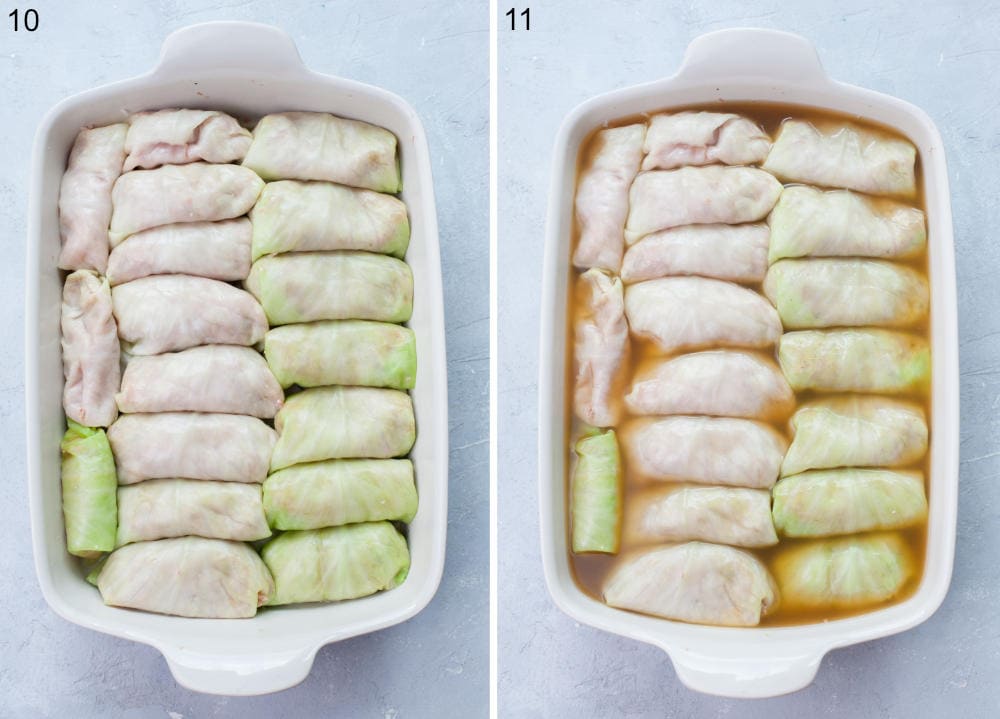
STEP 10: Preheat the oven to 350°F (180°C). Place a couple of cabbage leaves in a 9×13-inch casserole dish (22x32xm). Place the golabki seam side-down in the dish.
STEP 11: Pour in hot broth.
Cover the dish with a lid or aluminum foil then bake for 1 hour.
Uncover and bake for 15-30 minutes or until the cabbage is soft and the meat cooked through (take out 1 roll and cut it in half to check). Keep an eye on them if they’re not browning too much – if they are – you can cover them with aluminum foil.
Transfer the cabbage rolls to a plate, reserve the broth! Strain the broth through a fine-mesh strainer.
OR cook them on the stovetop
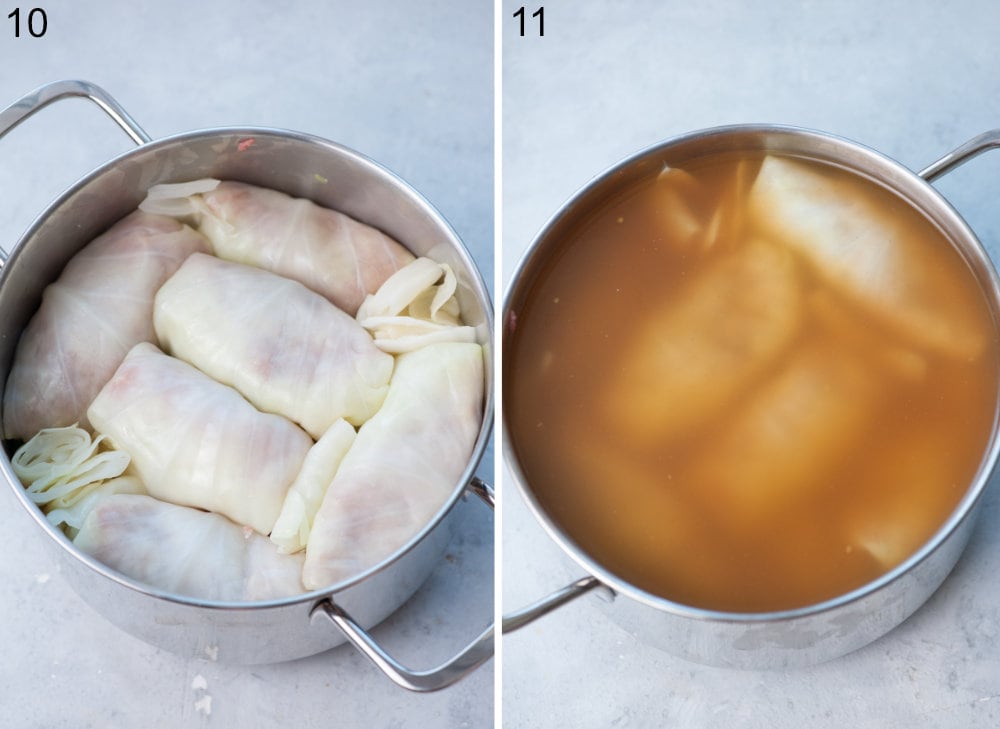
STEP 10: Pour a couple of tablespoons of broth into a large pot (please choose a bigger pot than on the photos..). Place a couple of cabbage leaves at the bottom (you can use damaged leaves for that).
Place stuffed cabbage rolls seam side-down in the pot. They should be very close to each other. Stack them in two layers. I’m putting the remaining cabbage between the rolls in the second layer so they are layered out more tightly.
STEP 11: Pour in the HOT broth – there should be enough broth to cover the rolls. Cover the pot with a lid.
Cook the cabbage rolls over low heat, they should be only simmering, for about 1 hour or until the cabbage is soft and the meat is cooked through (take out one cabbage roll and cut it in half to see if it’s done).
Transfer the cabbage rolls to a plate, reserve the broth! Strain the broth through a fine-mesh strainer.
Make the tomato sauce
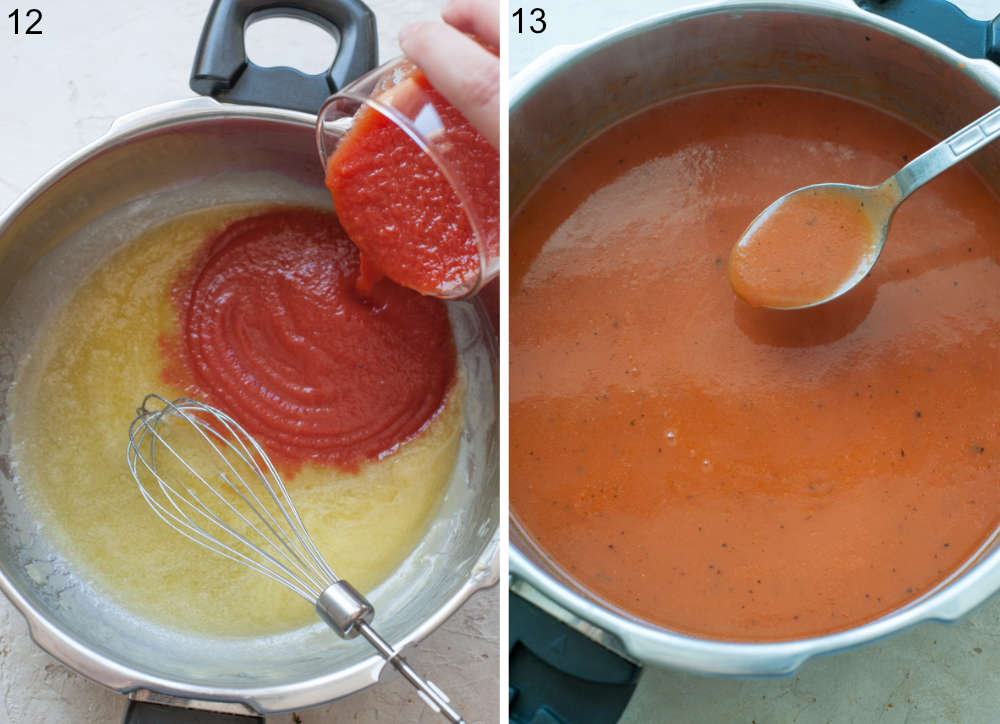
STEP 12: Add butter into a medium pot, cook until it’s melted.
Add the flour, whisk until combined then cook for a minute until the mixture is just lightly browned and smells nutty (whisk it constantly).
STEP 13: Add the broth, tomato passata, and basil. Cook over medium-low heat for 5-10 minutes until the sauce is thickened.
Whisk in the cream then season with salt and pepper.
Serve gołąbki with the tomato sauce.
Enjoy!
What to serve it with
I usually don’t make any side dishes for golabki. There’s meat, rice, and a sauce so I don’t feel the need, but you could serve them with mashed potatoes or buttered rye bread.
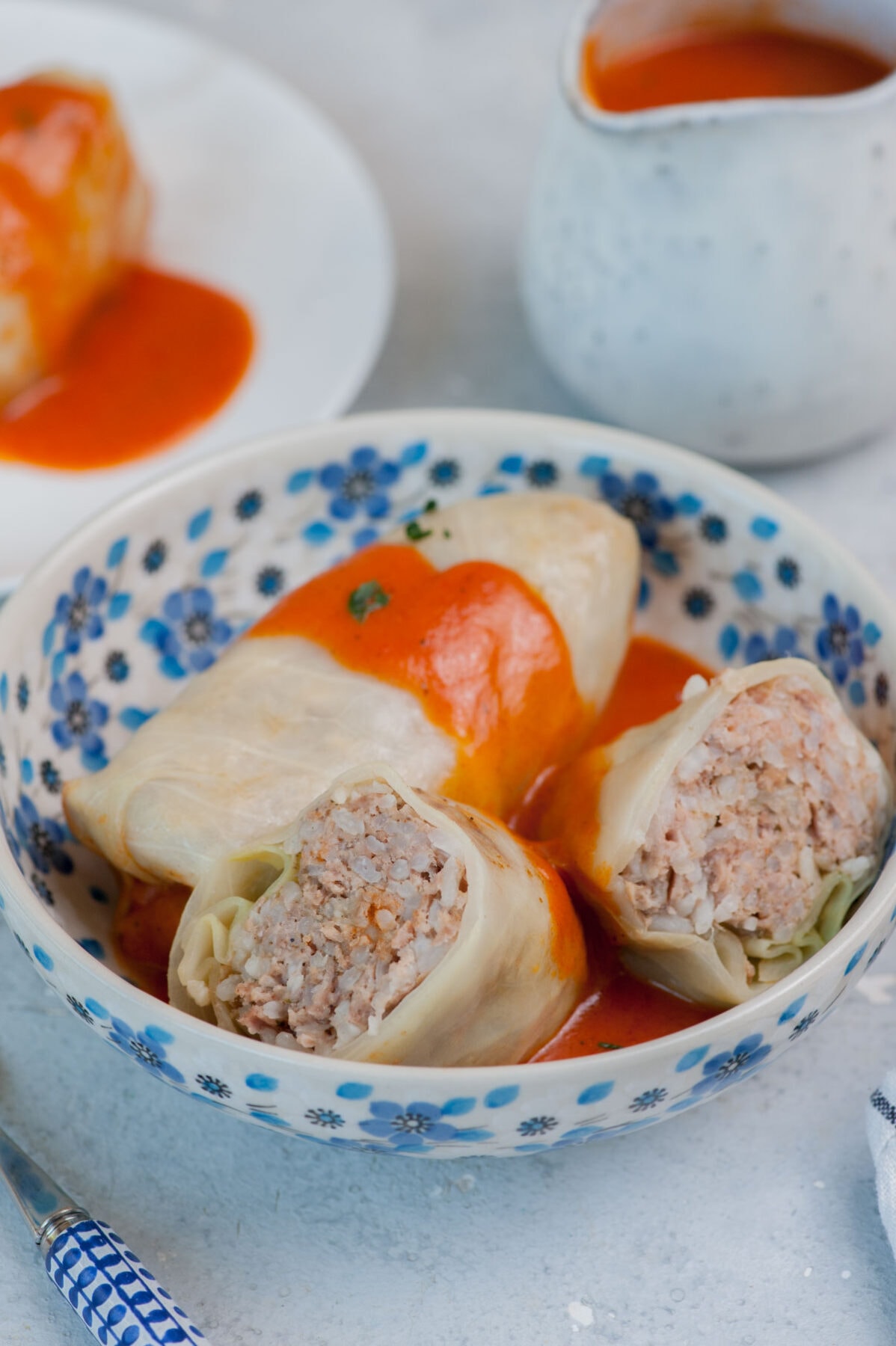
What to do with leftover meat-rice mixture
You can use it to make:
- soup (like this stuffed cabbage soup)
- stuffed zucchini
- little meatballs, you can put them in a soup
- stuffed peppers
- lazy stuffed cabbage (gołąbki leniwe) – mix meat-rice filling with shredded cabbage, form thick patties and bake in tomato sauce
What to do with leftover cabbage
- add it to a soup
- make łazanki (noodles with cabbage, sauerkraut, and kiełbasa)
- add it to a beef stew
Storage and freezing instructions
Gołąbki keep and freeze very well!
Storage: you can keep them for up to 3-4 days in the fridge, in an airtight container. I’m storing the cabbage rolls and the sauce separately but you can also store them together.
Freezing: you can freeze stuffed cabbage rolls for up to 3-4 months.
How to freeze: I’m freezing them wrapped in plastic foil (spaced out). I’m freezing the sauce separately.
To thaw:
- Thaw them in the fridge overnight them warm up in the oven (put them in cold oven and set it to 350°F/180°C, bake for 15-20 minutes or until warm, warm up the sauce separately in a pot).
- Bake them straight from the freezer – put them in a cold oven then set it to 325°F/160°C and bake for about 40-50 minutes until thawed and warm.
FAQ
They are overcooked. Don’t cook the cabbage for too long, just until the leaves are pliable.
You don’t. Golabki can be of different sizes – their cooking time stays the same. If you have really large leaves, you can cut them in half.
Just cook your cabbage rolls longer, don’t worry, they will be eventually cooked through!
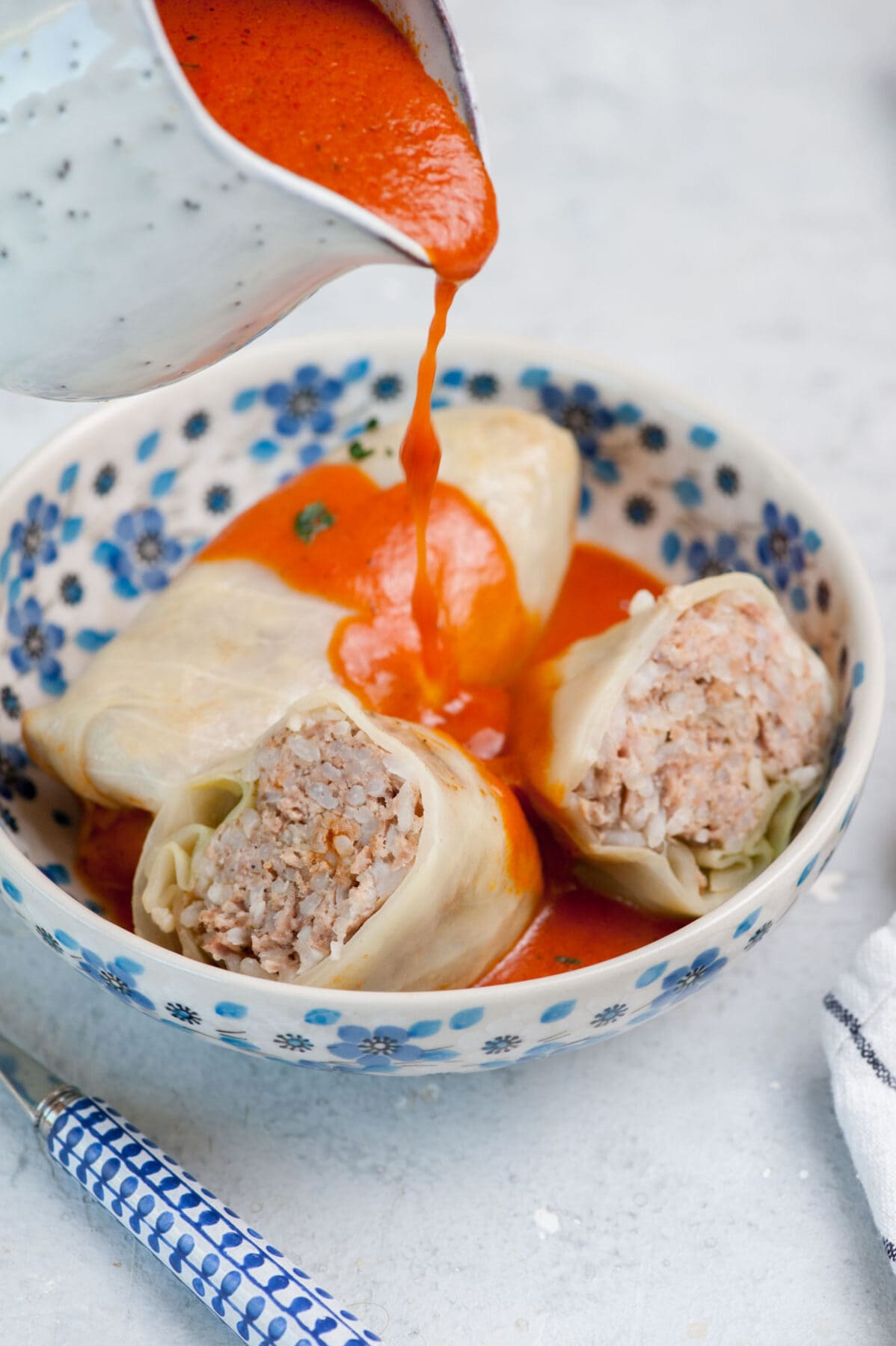
Did you make this recipe? RATE THE RECIPE or tell me in the COMMENTS how you liked it! You can also add a photo of your dish. It would make me very happy and will help other readers. Thank you!!
Gołąbki – Polish Stuffed Cabbage Rolls
składniki
for the stuffed cabbage:
- 1 large head cabbage
- 2 lbs ground pork and beef 900g (in total)
- 1 cup uncooked rice 200g
- 2 tablespoons frying oil
- 2 medium onions
- 4 cloves garlic
- 1 teaspoon marjoram
- 2 teaspoons thyme
- 1/2 teaspoon paprika
- salt and pepper
- 3 cups chicken broth
- 1 cup beef broth
for the tomato sauce:
- 1/4 cup butter 60g
- 2 tablespoons flour
- 2 cups tomato passata tomato puree
- 2 cups chicken broth leftover from cooking gołąbki
- 1 teaspoon dried basil
- 2 tablespoons heavy cream optional
- salt and pepper to taste
Would you like to save this?
wykonanie
Prepare the cabbage:
- Core the cabbage: using a pairing knife, cut out the core of the cabbage, about 1 1/2-2 inches (4-5cm) deep. Make sure to cut it out wide enough so that the leaves are not attached to the core.
- Cook the cabbage: In a large pot, bring a large amount of water to a boil (enough to cover the cabbage). Add the cabbage, core-side down, cook for 10 minutes, then turn it over (it should be core-side up now) and cook for a further 5 minutes.
- Peel the leaves off one by one using tongs while the cabbage is still in water, stack the leaves on a plate. Grab the cabbage with tongs by the stem, trying to not damage the leaves. The point here is not to cook the cabbage but to separate the leaves and soften them. They should not be completely soft (fully cooked) but only pliable. If the leaves are not separating try to separate them from the core with a knife (if you’ve cut out too little). If your cabbage leaves are still not soft enough to be easily pliable you can add them to the pot and cook them a little bit longer. Don’t overcook the cabbage or the leaves will tear.
- You will need about 16 leaves.
- Alternatively: you can core the cabbage, wrap it in plastic foil then freeze it whole. After it has been thawed you can peel the leaves easily and use them right away. It will take overnight to freeze it then overnight + a couple of hours on the counter to thaw it.
Prepare the meat-rice filling:
- Cook the rice until almost cooked – about 1-2 minutes shorter than the usual cooking time. Drain.
- Cut the onions into cubes, press the garlic through a garlic press. Heat the oil in a frying pan, add the onions, cook for 5-7 minutes until soft. Add the garlic and spices, cook, stirring, for 20-30 seconds. Add into a large bowl.
- Add the meat and cooked rice, season with salt and pepper (I added about 1 1/3 Tbsp of fine sea salt and 1 ts of ground black pepper but I prefer that you add them to your taste). Stir until the mixture is combined.
Stuff cabbage leaves:
- Cut out the thick part of the core.
- Place some of the filling in the middle of each leaf.
- Fold the right and left part of the leaf to the center.
- Roll up starting from the end facing towards you. Try to roll up the leaves tightly.
Bake stuffed cabbage rolls in the oven:
- Preheat the oven to 350°F (180°C).
- Place a couple of cabbage leaves in a 9×13-inch casserole dish (22x32xm). Place the golabki seam side-down in the dish.
- Pour in hot broth.
- Cover the dish with a lid or aluminum foil then bake for 1 hour. Uncover and bake for 15-30 minutes or until the cabbage is soft and the meat cooked through (take out 1 roll and cut it in half to check). Keep an eye on them if they're not browning too much – if they are – you can cover them with aluminum foil. The baking time will depend on the cabbage, if they're not done, just bake them a little bit longer.
- Transfer the cabbage rolls to a plate, reserve the broth! Strain the broth through a fine-mesh strainer.
OR cook them on the stovetop:
- Pour a couple of tablespoons of broth into a large pot. Place a couple of cabbage leaves at the bottom (you can use damaged leaves for that).
- Place stuffed cabbage rolls seam side-down in the pot. They should be very close to each other. Stack them in two layers. I’m putting the remaining cabbage between the rolls in the second layer so they are layered out more tightly.
- Pour in the HOT broth – there should be enough broth to cover the rolls. Cover the pot with a lid. Cook the cabbage rolls over low heat, they should be only simmering, for about 1 hour or until the cabbage is soft and the meat is cooked through (take out one cabbage roll and cut it in half to see if it's done).
- Transfer the cabbage rolls to a plate, reserve the broth! Strain the broth through a fine-mesh strainer.
Make the tomato sauce:
- Add butter into a medium pot, cook until it’s melted.
- Add the flour, whisk until combined then cook for a minute until the mixture is just lightly browned and smells nutty (whisk it constantly).
- Add the broth, tomato passata, and basil.
- Cook over medium-low heat for 5-10 minutes until the sauce is thickened.
- Whisk in the cream then season with salt and pepper.
- Serve gołąbki with the tomato sauce.
- Enjoy!
uwagi
- If the meat is not cooked through/golabki are tough/cabbage is not soft – this just means that the golabki were not cooked long enough.
- You can also use savoy cabbage instead of white cabbage. You can peel off the leaves without boiling the cabbage then cook the leaves for 3-5 minutes or until softened. Many people prefer golabki made with savoy cabbage but we like them with white cabbage more.
- You can also use young cabbage for this recipe. It’s much softer than winter cabbage so cook it for 8 minutes in total when making the leaves pliable then cook the cabbage rolls for about 30 minutes instead of an hour.
- You could also add roughly chopped sauteed mushrooms to the filling – it’s super delicious, or add crumbled bacon pieces to the filling or wrap each cabbage roll in bacon slices.
- Storage and freezing instructions – Gołąbki keep and freeze very well!
Storage: you can keep them for up to 3-4 days in the fridge, in an airtight container. I’m storing the cabbage rolls and the sauce separately but you can also store them together.
Freezing: you can freeze stuffed cabbage rolls for up to 3-4 months.
How to freeze: I’m freezing them wrapped in plastic foil (spaced out). I’m freezing the sauce separately.
To thaw:
– Thaw them in the fridge overnight them warm up in the oven (put them in a cold oven and set it to 350°F/180°C, bake for 15-20 minutes or until warm, warm up the sauce separately in a pot).
– Bake them straight from the freezer – put them in a cold oven then set it to 325°F/160°C and bake for about 40-50 minutes until thawed and warm. - Calories = 1 serving (2 cabbage rolls with sauce). This is only an estimate!


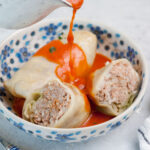
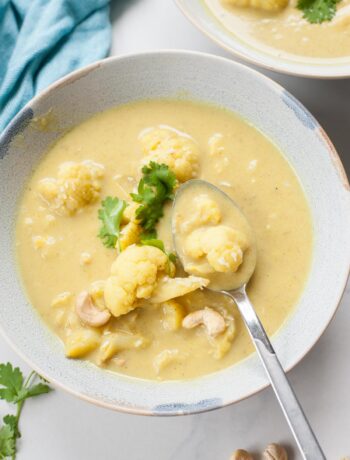
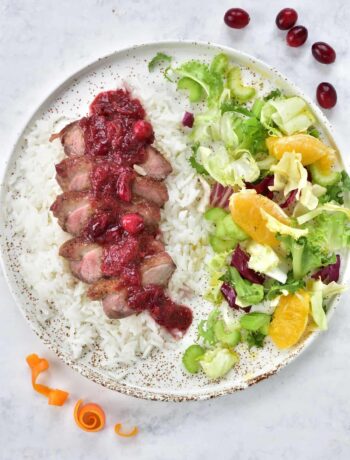
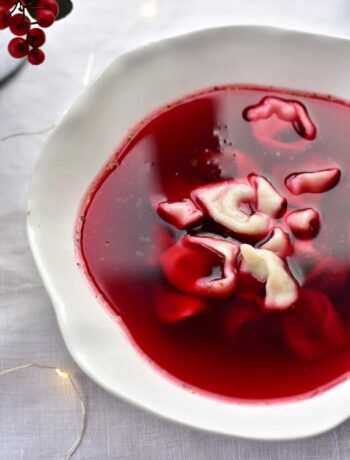
3 komentarze
Kelly
2 marca 2024 o 17:57This recipe is really close to the way my family makes them. Actually, we really don’t use a recipe so they’re never made quite the same but always similar and delicious. We usually all get together and make a giant batch which we divide among our households and freeze. We have them in pots on the stove, in the oven, and in an electric roaster.
One thing we do and all look forward to since we’re usually making them to freeze rather than eat the same day, is we take the leftover meat mixture (if any), the small inner cabbage leaves (cut up if necessary) and cubed potatoes and bake them in the pans alongside the Gołąbki. We eat this with the tomato sauce that day, usually with buttered rye bread.
Yve
27 listopada 2023 o 17:51I have a question: how much of the broth should be used for the sauce.
The first time I made this I had only a small amount left and I had to put in some more in the sauce. Yesterday I had to much left and since I threw it al in the sauce pot my sauce got to thin and had to boil for an hour to thicken…
Aleksandra
27 listopada 2023 o 18:52In the recipe card you have all the ingredients needed for the sauce and it says: „for the sauce: 2 cups chicken broth (leftover from cooking golabki)”. So if you don’t have enough broth, just add water or store-bought chicken broth until you have 2 cups, and if you have more than that, just use 2 cups and reserve the remaining broth for another dish. I hope this helps, reach out if you have any more questions.